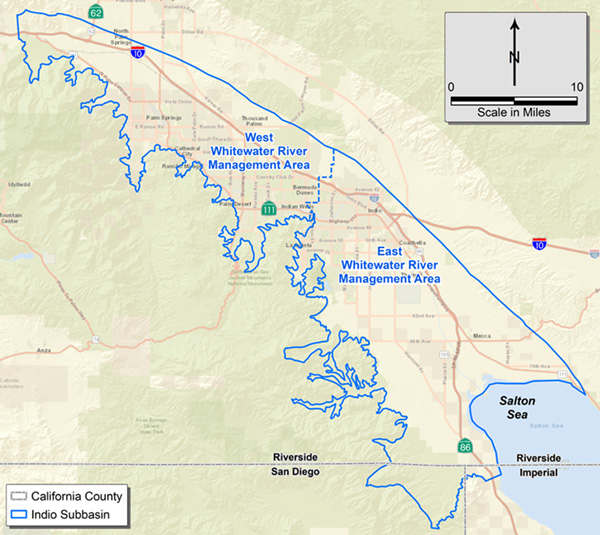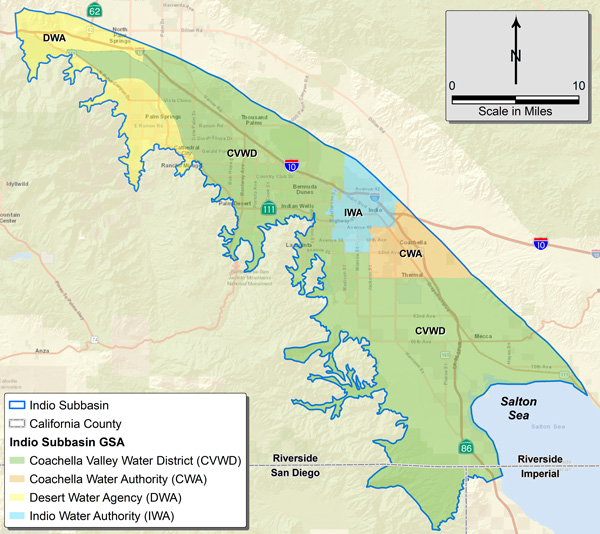Welcome to Indio Subbasin SGMA
Learn more and follow the development of the Indio Subbasin Alternative Plan Update
The Coachella Valley relies on groundwater as its main source of water supply for local homes and businesses. Groundwater is pumped by local wells and distributed for drinking and irrigation purposes. To offset the amount of water pumped by local wells, the region’s water agencies import water from the Colorado River to replenish the basin, recycle wastewater for irrigation, and incentivize conservation – this is called “groundwater management”. Local water agencies have been working on groundwater management since the 1940s when local leaders began importing water to supplement local groundwater supplies.
The Coachella Valley Groundwater Basin extends from the Whitewater River in the northwest to the Salton Sea in southeast. The Indio (Whitewater) Subbasin is the largest of four groundwater subbasins that make up the Coachella Valley Groundwater Basin. Historically, more groundwater was pumped out of the Indio Subbasin each year than the amount of water that naturally replenishes the groundwater basin. “Overdraft” occurs when a groundwater basin has pumping (demands) that exceed recharge (supplies) over the long term. If unmanaged, overdraft can reduce a region’s total available water supply and lead to other negative effects, such as drops in the water table and land subsidence. Agencies within the Indio Subbasin began to actively manage the Subbasin in 2002 with development of the 2002 Coachella Valley Water Management Plan in order to address this issue.
Given that many groundwater basins in California are in overdraft, the State of California passed the Sustainable Groundwater Management Act to require local agencies to balance demands and supplies in their basins.
The Coachella Valley relies on groundwater as its main source of water supply for local homes and businesses. Groundwater is pumped by local wells and distributed for drinking and irrigation purposes. To offset the amount of water pumped by local wells, the region’s water agencies import water from the Colorado River to replenish the basin, recycle wastewater for irrigation, and incentivize conservation – this is called “groundwater management”. Local water agencies have been working on groundwater management since the 1940s when local leaders began importing water to supplement local groundwater supplies.
Overview of SGMA

In 2014, California enacted the Sustainable Groundwater Management Act (SGMA). SGMA requires that a Groundwater Sustainability Plan (GSP) or Alternative Plan to a GSP (Alternative Plan) be adopted for basins and subbasins designated by the California Department of Water Resources (DWR) as medium- and high-priority basins. Basin prioritization is based on a variety of factors such as population, number of wells, and other information determined to be relevant by DWR.
SGMA requires that a Groundwater Sustainability Agency (GSA) (or Agencies – see Indio GSAs below) be established to manage the basin and develop the plan. The GSP or Alternative Plan must explain how the groundwater basin will be kept in balance, to achieve long term sustainability. DWR will evaluate each GSP or Alternative Plan in how well it will achieve basin sustainability.
Indio Subbasin
The Indio Subbasin is part of the Coachella Valley Groundwater Basin, which is designated as Basin No. 7-12.01 in the DWR Bulletin 118 (DWR, 2003).
The Indio Subbasin was designated as a medium-priority subbasin by DWR. The Indio Subbasin is surrounded by the San Bernardino Mountains on the north, the San Jacinto and Santa Rosa Mountains on the west, the Little San Bernardino Mountains on the east and the Salton Sea on the south.
The Indio Subbasin is the largest subbasin within the Coachella Valley Groundwater Basin, which also includes the San Gorgonio Pass, Mission Creek, and Desert Hot Springs subbasins. The four water agencies in the Indio Subbasin – Coachella Valley Water District (CVWD), Desert Water Agency (DWA), Coachella Water Authority (CWA), and Indio Water Authority (IWA) – are collaborating to manage the Indio Subbasin under SGMA.
History of Groundwater Planning
In 2002, recognizing that continued overdraft was a threat to the economy and quality of life in the Valley, CVWD developed the 2002 Coachella Valley Groundwater Management Plan in collaboration with other local stakeholders. The 2002 plan focused on reducing overdraft, preventing groundwater level decline, protecting groundwater quality, and preventing land subsidence (which is sinking of the land surface because of overdraft). In 2010, the 2010 Coachella Valley Groundwater Management Plan Update was prepared to document the accomplishments in reducing overdraft and address changed conditions since 2002. The basic goal of the 2010 plan is “to reliably meet current and future water demands in a cost-effective and sustainable manner.”
With the passage of SGMA, the water agencies collaboratively submitted the 2010 plan and supporting materials as an Alternative Plan. In July 2019, that Alternative Plan was approved by DWR, along with some recommendations for new information and requirement that an Alternative Plan Update be prepared by January 2022 (see Alternative Plan Update page), and every five years thereafter.
Indio GSAs

The four water agencies located within the Indio Subbasin have formed the Indio Subbasin Groundwater Sustainability Agencies (GSAs). These agencies are each exclusive GSAs that oversee and manage portions of the Indio Subbasin that overlay each of their respective service areas. These agencies led the development of the 2022 Indio Subbasin Water Management Plan Update: SGMA Alternative Plan. The final Alternative Plan Update was adopted and submitted to DWR in December 2021.
Upcoming Meetings
The next Public Workshop is scheduled for March 2025 to review the Annual Report for Water Year 2024.